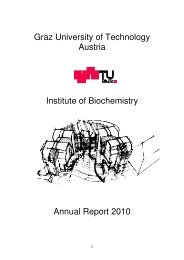Staff Members of the Institute of Biochemistry, TU - Institut für ...
Staff Members of the Institute of Biochemistry, TU - Institut für ...
Staff Members of the Institute of Biochemistry, TU - Institut für ...
You also want an ePaper? Increase the reach of your titles
YUMPU automatically turns print PDFs into web optimized ePapers that Google loves.
quinone <strong>the</strong>reby catalyzing <strong>the</strong> formation <strong>of</strong> a fully reduced hydroquinone. Interestingly, those<br />
enzymes are found in solid tumours at increased levels and thus can be used to target <strong>the</strong> tumour<br />
cell through bioreductive activation <strong>of</strong> prodrugs. Here <strong>the</strong> identification and characterization <strong>of</strong><br />
Lot6p, a soluble, flavin-dependent quinone reductase from Saccharomyces cerevisiae is described.<br />
It is shown that Lot6p is capable <strong>of</strong> reducing a variety <strong>of</strong> substrates at <strong>the</strong> expense <strong>of</strong> ei<strong>the</strong>r NADH<br />
or NADPH via a ping-pong bi bi reaction mechanism. Recent studies using human quinone<br />
reductases demonstrated that this enzyme binds to <strong>the</strong> 20S proteasome and affects <strong>the</strong> lifetime <strong>of</strong><br />
transcription factors, such as tumour suppressor p53, by inhibiting <strong>the</strong>ir intracellular degradation.<br />
It could be shown that Lot6p is physically associated with <strong>the</strong> yeast proteasome. Fur<strong>the</strong>rmore,<br />
quinone reductase lacking <strong>the</strong> flavin c<strong>of</strong>actor was unable to bind to <strong>the</strong> proteasome indicating that<br />
only <strong>the</strong> holo-protein can form a protein complex. Interaction <strong>of</strong> Lot6p with <strong>the</strong> proteasome is<br />
independent <strong>of</strong> <strong>the</strong> redox state <strong>of</strong> <strong>the</strong> flavin. However, reduction <strong>of</strong> <strong>the</strong> FMN c<strong>of</strong>actor triggers<br />
association <strong>of</strong> <strong>the</strong> complex with Yap4p, a transcription factor involved in <strong>the</strong> oxidative stress<br />
response. Moreover, Yap4p was detected in <strong>the</strong> nucleus <strong>of</strong> quinone stressed yeast cells, but not in<br />
<strong>the</strong> nucleus <strong>of</strong> non-stressed wild-type cells. This finding suggests that stress causes <strong>the</strong> release <strong>of</strong><br />
<strong>the</strong> transcription factor from <strong>the</strong> protein complex resulting in concomittant relocalisation to <strong>the</strong><br />
nucleus. Sequestration <strong>of</strong> a transcription factor by a quinone-reductase-proteasome complex<br />
discovered here is similar to findings in mammalian cells.<br />
Our data also reveal that <strong>the</strong> redox state <strong>of</strong> <strong>the</strong> flavin c<strong>of</strong>actor controls recruitment <strong>of</strong> <strong>the</strong><br />
transcription factor Yap4p to <strong>the</strong> quinone reductase-proteasome complex. This would imply that<br />
stability and localization <strong>of</strong> Yap4p are under direct redox control <strong>of</strong> <strong>the</strong> Lot6p-proteasome<br />
complex. Under reducing conditions (when an excess <strong>of</strong> NAD(P)H is present in <strong>the</strong> cell), Yap4p is<br />
bound to <strong>the</strong> quinone reductase-proteasome system, virtually in a stand-by position. In <strong>the</strong><br />
presence <strong>of</strong> quinones (i.e., when oxidative stress is applied to <strong>the</strong> cell), Yap4p is released from <strong>the</strong><br />
complex and rapidly relocalizes to <strong>the</strong> nucleus where it is now able to switch on stress-related<br />
target genes.<br />
Andreas Winkler: Structure-function studies on berberine bridge enzyme from <strong>the</strong> California<br />
poppy (Eschscholzia californica)<br />
Berberine bridge enzyme catalyzes <strong>the</strong> oxidative conversion <strong>of</strong> (S)-reticuline to (S)-scoulerine by<br />
formation <strong>of</strong> a C-C bond between <strong>the</strong> N-methyl group and <strong>the</strong> phenolic moiety <strong>of</strong> <strong>the</strong> substrate.<br />
This reaction leads to ring closure and is unique to <strong>the</strong> biosyn<strong>the</strong>sis <strong>of</strong> benzophenanthridine<br />
alkaloids with no direct equivalent in organic chemistry. We <strong>the</strong>refore set out to characterize <strong>the</strong><br />
molecular mechanism by means <strong>of</strong> a functional and structural analysis <strong>of</strong> <strong>the</strong> enzyme. The<br />
biochemical characterization <strong>of</strong> <strong>the</strong> flavin c<strong>of</strong>actor revealed that it is covalently linked to <strong>the</strong><br />
protein backbone via two amino acids (His-104 and Cys-166). At <strong>the</strong> time <strong>of</strong> discovery this<br />
unusual bicovalent mode <strong>of</strong> FAD attachment was just recently identified during <strong>the</strong> structural<br />
analysis <strong>of</strong> a distantly related enzyme. We could show that this dual mode <strong>of</strong> c<strong>of</strong>actor linkage<br />
increases <strong>the</strong> redox potential to <strong>the</strong> highest value reported for flavoenzymes so far (+132 mV). The<br />
analysis <strong>of</strong> mutant proteins lacking each <strong>of</strong> <strong>the</strong>se linkages (H104A and C166A) confirmed <strong>the</strong>ir<br />
contribution to <strong>the</strong> elevated redox potential (-100 and -80 mV difference, respectively) but in<br />
addition also demonstrated <strong>the</strong>ir importance for correct positioning <strong>of</strong> <strong>the</strong> substrate in <strong>the</strong> active<br />
site allowing efficient turnover. These conclusions were supported by <strong>the</strong> elucidation <strong>of</strong> <strong>the</strong> crystal<br />
structures <strong>of</strong> wild type BBE as well as those <strong>of</strong> <strong>the</strong> mutant proteins H104A and C166A.<br />
Comparing <strong>the</strong> active site architecture between <strong>the</strong>se structures demonstrated that <strong>the</strong> overall<br />
positioning <strong>of</strong> <strong>the</strong> c<strong>of</strong>actor is only slightly affected by <strong>the</strong> removal <strong>of</strong> <strong>the</strong> covalent linkages, while<br />
surrounding amino acids respond significantly to replacement <strong>of</strong> ei<strong>the</strong>r His-104 or Cys-166.<br />
Especially <strong>the</strong> flexibility <strong>of</strong> Trp-165, which plays an important role during <strong>the</strong> conversion <strong>of</strong><br />
12














